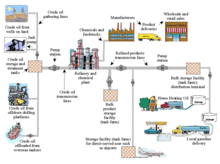
Back منتصف المجرى (صناعة البترول) Arabic Midstream Spanish میاندستی Persian Midstream-liiketoiminta Finnish Industri antara ID Midstream Italian Midstream Turkish


The oil and gas industry is usually divided into three major components: upstream, midstream and downstream. The midstream sector involves the transportation (by pipeline, rail, barge, oil tanker or truck), storage, and wholesale marketing of crude or refined petroleum products. Pipelines and other transport systems can be used to move crude oil from production sites to refineries and deliver the various refined products to downstream distributors.[1][2][3] Natural gas pipeline networks aggregate gas from natural gas purification plants and deliver it to downstream customers, such as local utilities.
The midstream operations are often taken to include some elements of the upstream and downstream sectors. For example, the midstream sector may include natural gas processing plants that purify the raw natural gas as well as removing and producing elemental sulfur and natural gas liquids (NGL) as finished end-products.
- ^ "Petroleum industry". Archived from the original on 2013-04-12. Retrieved 2013-05-23.
- ^ "Upstream, midstream & downstream". Archived from the original on 2014-01-07. Retrieved 2014-01-07.
- ^ Petroleum Services Association of Canada (PSAC), Industry Overview Archived 2017-05-08 at the Wayback Machine
© MMXXIII Rich X Search. We shall prevail. All rights reserved. Rich X Search